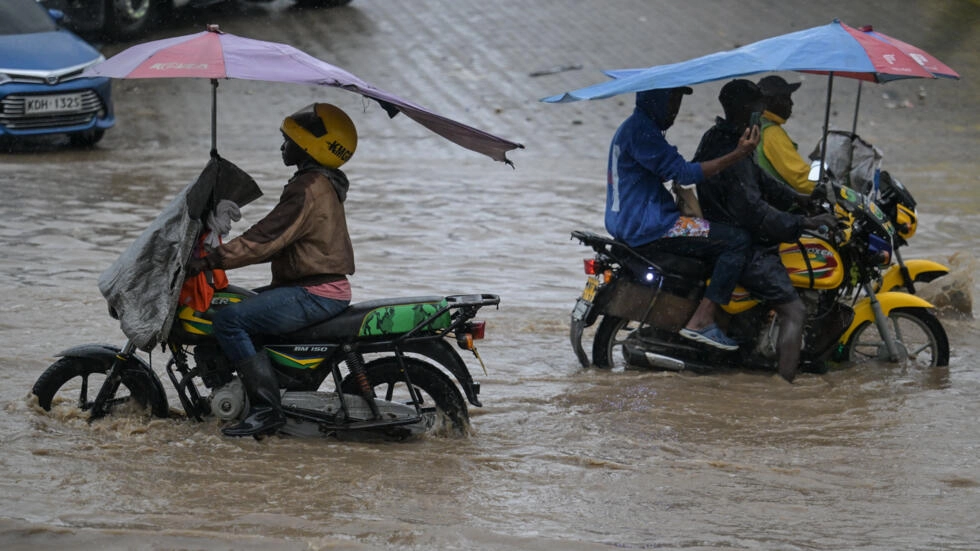Around 80 people in Kenya and Somalia have lost their lives in less than a month as a result of floods caused by heavy rains, which come on the heels of East Africa’s worst drought in decades.
Humanitarian organisations in East Africa report that close to a million people have been displaced in the two countries, with Somalia bearing the brunt.
With more downpours forecast, at least 46 people in Kenya had lost their lives by 13 November, the Cabinet Secretary of Interior and Administration, Kindiki Kithure, confirmed.
The arid and semi-arid regions of eastern and northern Kenya are the most affected.
“We have lost 46 people because of drowning and floods, and we don’t want any other Kenyan to lose their lives. Please comply with directives by security officers, and if you don’t comply, we will force you to comply,” warned Kindiki on a visit to Garissa County, one of 19 of Kenya’s 47 counties that have been affected adversely by the floods.
The floods came less than three months after a prolonged drought that resulted in the death of livestock in both Kenya and Somalia. In Kenya, the National Drought Management Authority reported that as of September, 23 regions were severely hit and more than 2.8 million people affected.
The Kenya Red Cross said the country was experiencing “crisis upon crisis”.
“From a humanitarian perspective, what this means is that the resilience of these communities is consistently being weakened,” the charity’s secretary general, Ahmed Idris, told Citizen TV Kenya.
“Every subsequent emergency makes it more difficult for them to withstand the effects of the following emergency.”
Somali land at risk
In Somalia, where the drought was the worst to hit the country in 40 years, the UN Office for the Coordination of Humanitarian Affairs (OCHA) estimates that the lives of some 1.6 million people in Somalia could now be disrupted by floods.
Some 1.5 million hectares of farmland are at risk of being destroyed during the rainy season that lasts until December, it said.
At least 32 people have already died in Somalia’s flash floods, according to Save the Children.
The United Nations has termed the situation a “once-in-a-century event” – one of the most severe floods ever experienced in Somalia, one of Africa’s poorest nations.
Hundreds displaced
Transport connecting counties in the northern and eastern regions of Kenya has been paralysed for weeks as bridges and roads have been washed away.
The regional coordinator for the Kenya Red Cross in the eastern coastal region, Hassan Musa, told RFI that health services were suffering as the floods cut off crucial road links.
In Tana River County, 200 families have been left homeless after the river broke its banks. People have been forced to camp in schools located in high-altitude areas after their homes were swept away.
Fatuma Mlongo Mwambire, a mother of one, said: “Our houses have been swept away. We are here in the camp, we cannot access clean water. At night we cannot sleep, mosquitoes are all over, it is very cold as well.”
In the town of Maua in nearby Meru County, more than 100 families have been displaced.
“Drainage is poor here, our houses are flooded and property destroyed. We don’t have electricity and from the look of things, it is getting worse,” resident Gathabai Mwongera told RFI.
“I just don’t know what to do.”
Agricultural losses
In Nandi County in the north of the Rift Valley, one of Kenya’s rich agricultural areas, farmers told RFI they cannot take their produce to market after a bridge was torn away.
“I cannot get to Kapsabet because the bridge is not there. I know it will take time before the government fixes it – imagine the loss,” lamented tea farmer Daniel Kiptoo.
The floods are also causing the loss of livestock. So far more than 7,600 animals have been swept away in different parts of the country.
‘Caught off-guard’
Leaders from the affected counties in Kenya have blamed the country’s meteorological department and the national government for failing to prepare for the rains.
“The met department misadvised the president. What followed next saw everyone sleep on the job and we were caught off-guard,” said Ahmed Abdullah, the governor of Wajir County where more than 10,000 households have been caught up in the floods.
While international forecasters including the World Meteorological Organisation predicted that the East African region could experience heavy rainfall linked to the El Niño weather phenomenon, the Kenya Meteorological Department downplayed the risk.
That prompted President William Ruto to tell Kenyans at the end of October not to expect El Niño rains.
The meteorological office has since issued an apology.
El Nino is typically associated with increased heat worldwide, as well as drought in some parts of the world and heavy rains elsewhere. It is expected to last until at least April 2024.

